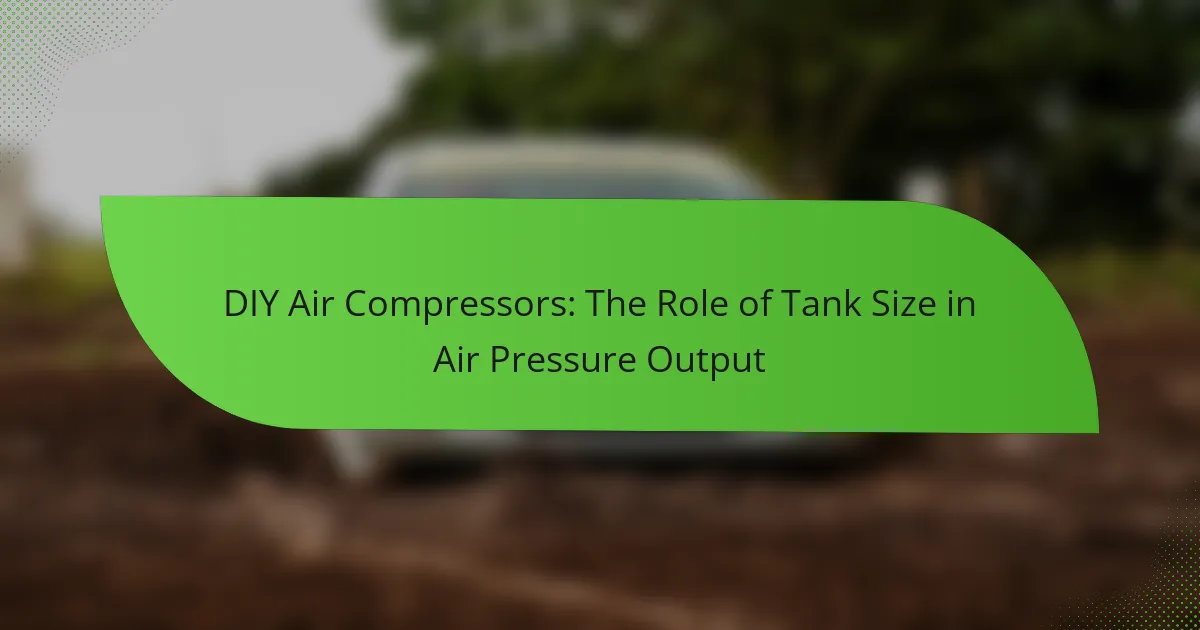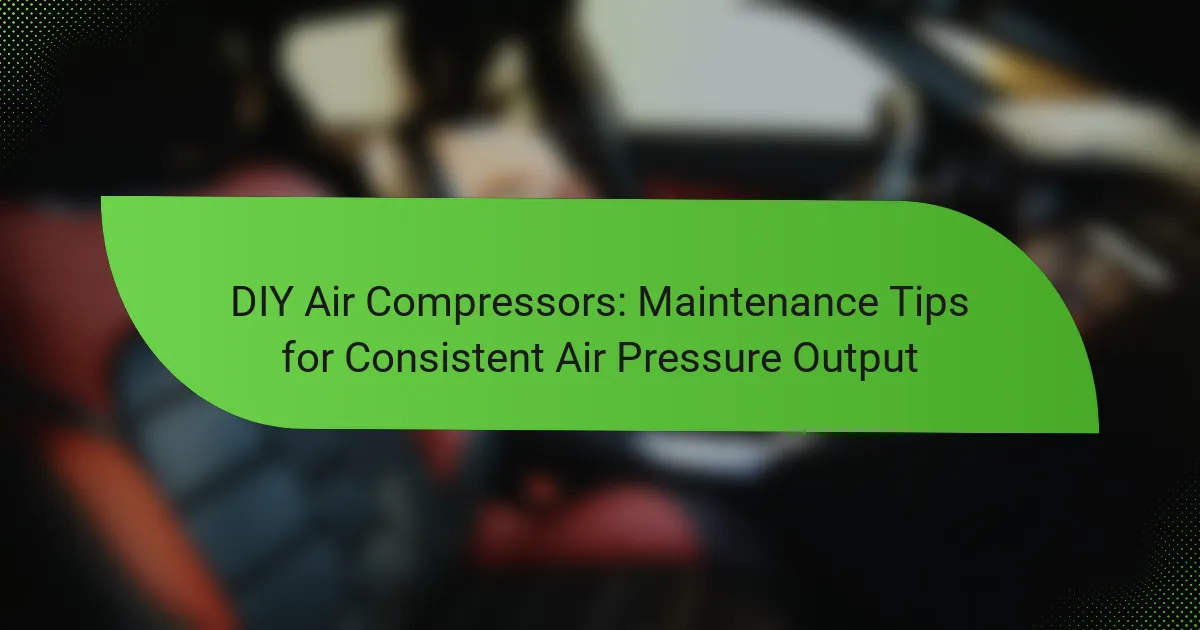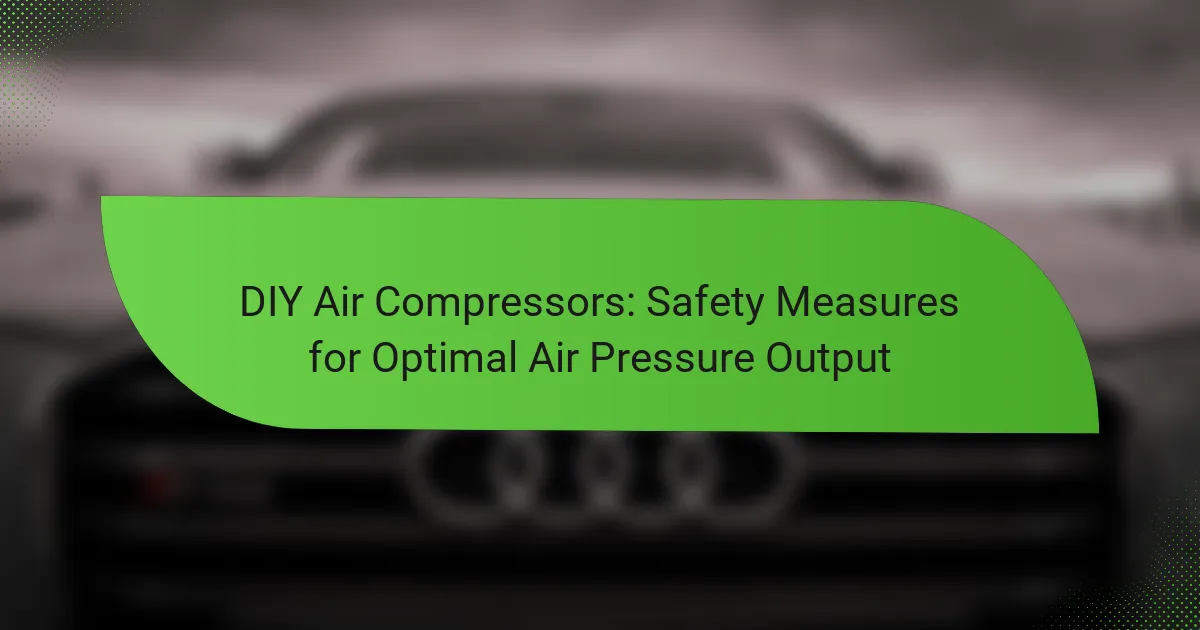DIY air compressors are devices that convert electrical power into potential energy stored in pressurized air, consisting of a motor, pump, and storage tank. This article explores the functionality and applications of DIY air compressors, emphasizing the significance of air pressure output measured in PSI (pounds per square inch) across different models. It details how various factors, such as tank size and design, influence efficiency and suitability for tasks like inflating tires, powering pneumatic tools, and spray painting. Additionally, the article outlines best practices for safe operation and maintenance to enhance the lifespan and effectiveness of DIY air compressors.
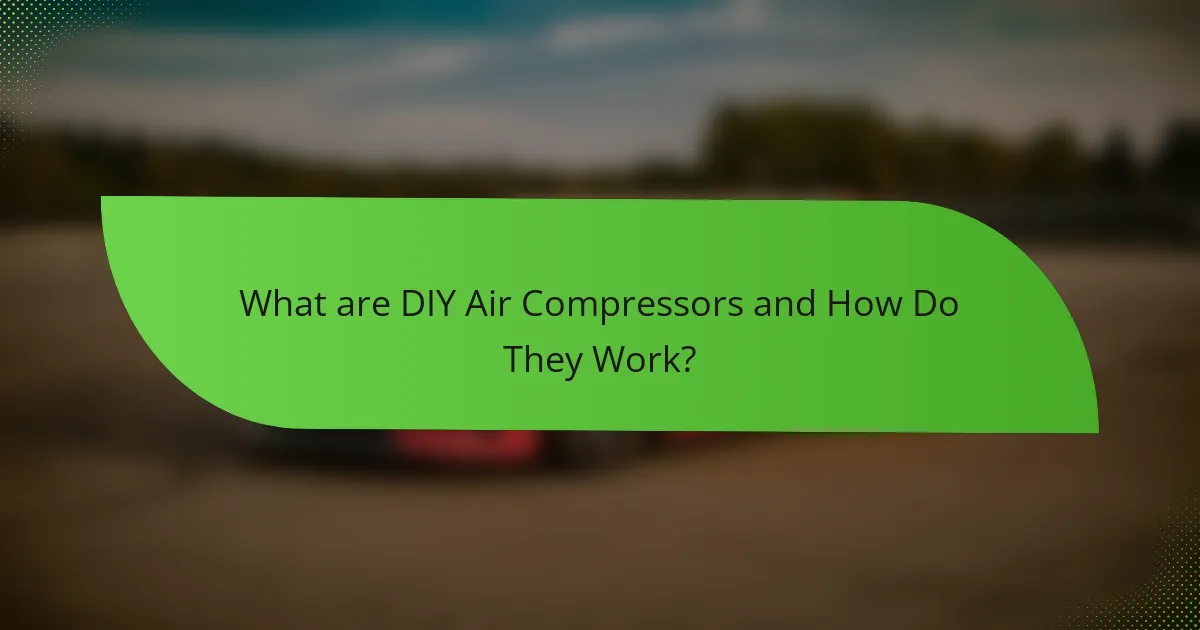
What are DIY Air Compressors and How Do They Work?
DIY air compressors are devices that convert power into potential energy stored in pressurized air. They typically consist of a motor, a pump, and a storage tank. The motor drives the pump, which compresses air and fills the tank. As the air is compressed, its pressure increases, allowing it to be used for various applications. Common uses include inflating tires, powering pneumatic tools, and spraying paint. DIY air compressors can be built using various components, such as repurposed electric motors and tanks. The efficiency and output pressure depend on the design and materials used. Understanding these factors helps in comparing air pressure output across different models.
What are the key components of a DIY air compressor?
The key components of a DIY air compressor include a motor, a pump, a tank, and a pressure switch. The motor powers the pump, which compresses the air. The tank stores the compressed air for later use. The pressure switch regulates the air pressure in the tank. Additionally, an air filter and pressure gauge are often included for better performance and monitoring. These components work together to create and maintain air pressure suitable for various applications.
How does each component contribute to air pressure output?
The components of an air compressor significantly influence air pressure output. The motor generates power to compress air. The pump compresses the air, increasing its pressure. The tank stores compressed air, allowing for consistent pressure delivery. The pressure switch regulates the air pressure by turning the motor on and off. The intake filter ensures clean air enters the system, preventing contaminants from affecting performance. The pressure gauge provides real-time pressure readings, helping users monitor output. Each component’s efficiency directly affects the overall air pressure output. High-quality components typically yield better performance and reliability.
What are the different types of DIY air compressors available?
The different types of DIY air compressors available include reciprocating, rotary screw, diaphragm, and portable models. Reciprocating compressors use pistons to compress air and are common for home use. Rotary screw compressors utilize two screws to compress air and are efficient for continuous operation. Diaphragm compressors are known for their ability to handle corrosive materials and provide a steady airflow. Portable air compressors are lightweight and designed for easy transport, ideal for small tasks. Each type serves specific needs based on pressure output and application.
What factors influence air pressure output in DIY air compressors?
The factors influencing air pressure output in DIY air compressors include compressor type, motor power, tank size, and ambient temperature. Different compressor types, such as reciprocating and rotary screw, have varying efficiencies and pressure capabilities. Motor power directly affects the compressor’s ability to generate higher pressure levels. A larger tank size allows for more air storage, which can stabilize pressure output during use. Additionally, higher ambient temperatures can decrease air density, impacting pressure output. These factors collectively determine the overall performance and effectiveness of DIY air compressors in producing desired air pressure levels.
How does tank size affect air pressure and performance?
Tank size directly impacts air pressure and performance in air compressors. Larger tanks can store more compressed air, leading to a more consistent pressure output. This allows for longer run times without the motor cycling on and off frequently. Smaller tanks may deplete air pressure quickly, resulting in less efficient operation.
As the tank size increases, the compressor can maintain a higher average pressure over extended periods. This is particularly beneficial for tools requiring sustained air pressure, such as nail guns or spray painters.
Research indicates that compressors with larger tanks can deliver air at a stable pressure for longer durations. A study by the American Society of Mechanical Engineers highlights that air pressure stability is crucial for tool performance. Thus, tank size is a critical factor in determining overall compressor efficiency and effectiveness.
What role does the motor power play in air pressure output?
Motor power directly influences air pressure output in air compressors. Higher motor power typically results in increased air compression efficiency. This efficiency enhances the compressor’s ability to generate higher pressure levels. For instance, a 2 HP motor can produce more air pressure than a 1 HP motor. The relationship between motor power and pressure output is linear to an extent. As motor power increases, the compressor can compress more air in a given time. This is crucial for applications requiring consistent high pressure. Therefore, motor power is a key determinant of an air compressor’s performance.
What are the advantages of using DIY air compressors?
DIY air compressors offer several advantages. They are often more cost-effective than commercial models. Building your own allows for customization to meet specific needs. DIY models can be tailored for size and power requirements. They often utilize readily available materials. This accessibility encourages creativity and innovation. Additionally, assembling a DIY air compressor can enhance technical skills. It provides a deeper understanding of pneumatic systems.
How can DIY air compressors save costs compared to commercial models?
DIY air compressors save costs compared to commercial models by reducing initial purchase expenses. Commercial models often have high price tags due to brand premiums and advanced features. In contrast, DIY models can be assembled using inexpensive components. This allows users to tailor the compressor to their specific needs without overspending. Additionally, maintenance costs for DIY compressors tend to be lower. Users can easily replace parts as needed, avoiding costly repairs from commercial services. Studies indicate that DIY solutions can save up to 50% on initial costs compared to retail options. This cost-effectiveness makes DIY air compressors a viable alternative for budget-conscious consumers.
What customization options are available for DIY air compressors?
Customization options for DIY air compressors include tank size, pressure settings, and compressor type. Users can select different tank sizes to accommodate specific air volume needs. Adjustable pressure settings allow for tailored output based on various tasks. Additionally, users can choose between reciprocating and rotary screw compressors for different performance levels. Other options include adding filters, regulators, and gauges for enhanced functionality. Customizing the intake and exhaust systems can also improve efficiency. These modifications can significantly impact the compressor’s overall performance and versatility.

How Do Different Models Compare in Air Pressure Output?
Different models of air compressors vary significantly in air pressure output. Typically, this output is measured in PSI (pounds per square inch). For instance, portable models often deliver between 70 to 100 PSI. In contrast, industrial-grade models can reach outputs of 150 PSI or more.
The air pressure output directly affects the compressor’s efficiency and suitability for specific tasks. Higher PSI ratings allow for more demanding applications, such as spray painting or powering pneumatic tools.
Research indicates that larger tanks in compressors often correlate with higher pressure outputs. For example, a 6-gallon tank may achieve 90 PSI, while a 20-gallon tank can exceed 150 PSI.
These comparisons highlight the importance of selecting the right model based on required air pressure for intended uses.
What metrics should be considered when comparing air pressure output?
Key metrics for comparing air pressure output include maximum pressure, flow rate, and recovery time. Maximum pressure indicates the highest pressure the compressor can achieve, typically measured in psi (pounds per square inch). Flow rate measures the volume of air delivered per minute, usually in CFM (cubic feet per minute). Recovery time refers to how quickly the compressor returns to its maximum pressure after use. These metrics help evaluate performance across different models, ensuring suitability for specific tasks. For example, a higher CFM is essential for tools requiring more air, while a lower recovery time enhances efficiency during use.
How do PSI and CFM ratings affect performance?
PSI (Pounds per Square Inch) and CFM (Cubic Feet per Minute) ratings significantly affect the performance of air compressors. PSI measures the air pressure delivered by the compressor. Higher PSI ratings indicate the ability to power tools that require more pressure. CFM measures the volume of air the compressor can deliver. A higher CFM rating allows for the operation of multiple tools simultaneously or tools that require a larger volume of air.
For example, a compressor with 90 PSI and 4 CFM can efficiently power a nail gun. In contrast, a compressor with 120 PSI and 6 CFM can run both a nail gun and an air sander at the same time. Therefore, understanding both ratings is crucial for selecting the right compressor for specific tasks.
What is the significance of duty cycle in comparing models?
The duty cycle is significant in comparing air compressor models as it indicates the ratio of operational time to rest time. A higher duty cycle means the compressor can run longer without overheating. This directly affects performance and efficiency. Models with a 100% duty cycle can operate continuously, making them suitable for demanding tasks. In contrast, models with lower duty cycles require more frequent breaks, impacting productivity. Therefore, understanding duty cycle helps users select a compressor that meets their specific needs.
Which DIY air compressor models are recommended for high air pressure output?
The recommended DIY air compressor models for high air pressure output include the California Air Tools CAT-1P1060S, the Bostitch BTFP02012, and the DEWALT D55140. The California Air Tools model delivers a maximum pressure of 120 PSI. It features a quiet operation at only 56 decibels. The Bostitch model offers a maximum pressure of 150 PSI. It is known for its lightweight and portable design. The DEWALT compressor also reaches a maximum of 135 PSI. It is equipped with a durable design suitable for various tasks. These models are widely recognized for their efficiency and reliability in providing high air pressure output.
What are the top-rated models based on user reviews and performance?
The top-rated models based on user reviews and performance include the California Air Tools 8010, the DEWALT D55140, and the Makita MAC2400. The California Air Tools 8010 is praised for its ultra-quiet operation at 60 decibels. It delivers 2.20 CFM at 90 PSI, making it efficient for various tasks. The DEWALT D55140 is noted for its portability and durability. It provides 0.9 CFM at 90 PSI and features a 10-gallon tank. The Makita MAC2400 is recognized for its powerful 2.5 HP motor. It generates 4.2 CFM at 90 PSI, suitable for heavy-duty applications. User reviews highlight these models for their reliability and performance across different DIY projects.
How do these models differ in design and functionality?
Different DIY air compressor models vary in design and functionality primarily based on their motor type and tank capacity. Electric models typically offer quieter operation and are suitable for indoor use. Gas-powered models provide higher portability and are ideal for outdoor tasks.
Tank capacity influences the volume of compressed air available. Larger tanks can store more air, allowing for longer usage without needing to refill. Additionally, some models feature adjustable pressure settings, enhancing versatility for various applications.
The design may include features like portability, weight, and size. Compact models are easier to store and transport, while larger models may offer more power.
Functionality also varies with features such as built-in gauges, regulators, and safety mechanisms. These elements improve user control and safety during operation.
Overall, the differences in design and functionality cater to specific needs and preferences among users.
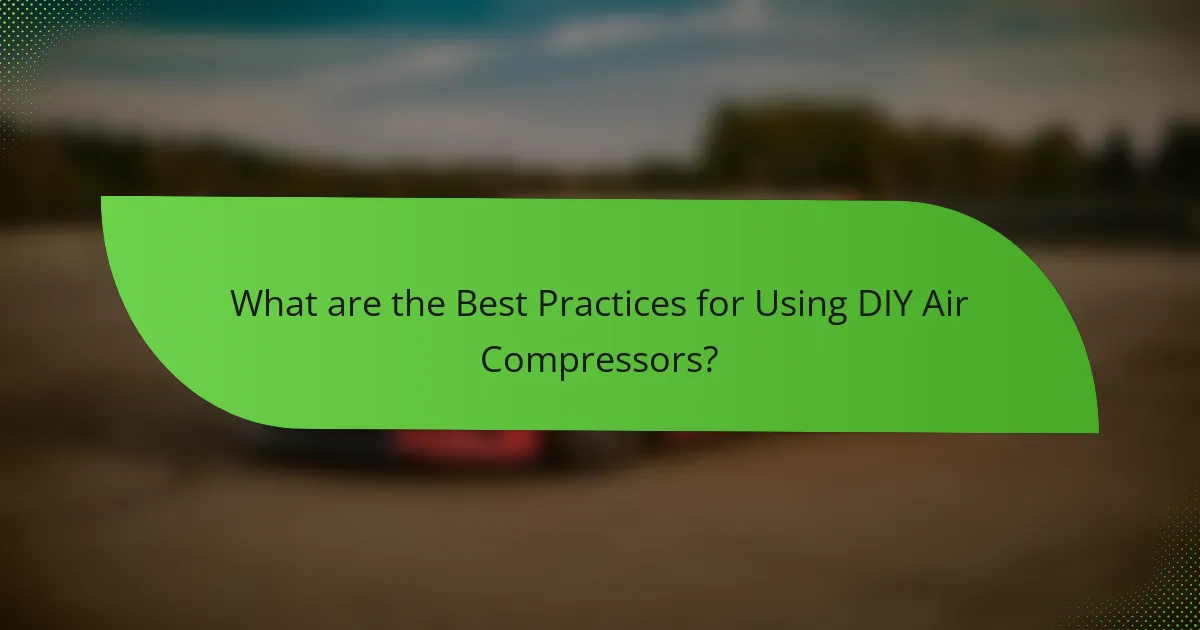
What are the Best Practices for Using DIY Air Compressors?
Ensure proper ventilation when using DIY air compressors. This prevents the buildup of harmful fumes. Regularly check for leaks in hoses and fittings. Leaks can lead to reduced efficiency and increased wear. Always use the appropriate pressure settings for your tools. Using too high pressure can damage tools and create safety hazards. Keep the compressor clean and free from debris. A clean unit operates more efficiently and lasts longer. Store the compressor in a dry place to prevent rust. Following these practices enhances safety and extends the lifespan of DIY air compressors.
How can users maximize the efficiency of their DIY air compressors?
Users can maximize the efficiency of their DIY air compressors by ensuring proper maintenance and optimal setup. Regularly checking and replacing air filters can improve airflow and reduce strain on the motor. Using the right size of air hose minimizes pressure loss during operation. Additionally, maintaining appropriate tank pressure levels enhances performance. Keeping the compressor in a cool, dry environment prevents overheating. Utilizing a pressure regulator helps maintain consistent output pressure. Following these practices can lead to improved efficiency and longevity of the air compressor.
What maintenance tips are essential for optimal performance?
Regular maintenance is essential for optimal performance of DIY air compressors. Check the air filter frequently and replace it as needed. Clean the compressor’s exterior to prevent dust buildup. Inspect and tighten all connections to avoid leaks. Drain the moisture from the tank regularly to prevent rust. Lubricate moving parts according to the manufacturer’s instructions. Test the pressure relief valve to ensure it operates correctly. Following these tips can extend the compressor’s lifespan and improve efficiency.
How can users troubleshoot common issues with air pressure output?
Users can troubleshoot common issues with air pressure output by checking the air filters and ensuring they are clean. Clogged filters can restrict airflow, leading to decreased pressure. Next, users should inspect the hoses for leaks or blockages. Any damage to the hoses can result in significant pressure loss. Additionally, users should verify that the pressure regulator is functioning correctly. A malfunctioning regulator can cause inconsistent output. Users can also check the tank for proper filling; an empty or near-empty tank will not provide adequate pressure. Lastly, reviewing the manufacturer’s specifications for optimal settings can help users ensure they are operating the compressor within recommended parameters.
What safety precautions should be taken when using DIY air compressors?
Always wear safety goggles when using DIY air compressors. This protects your eyes from debris and potential projectiles. Ear protection is also essential due to the loud noise produced. Ensure the compressor is placed on a stable surface to prevent tipping. Use the correct pressure settings according to the manufacturer’s guidelines. Regularly check hoses and connections for wear or damage. Avoid overfilling the tank to prevent pressure-related hazards. Keep the area clear of flammable materials, as air compressors can generate heat. Always turn off and unplug the compressor when not in use to prevent accidental activation.
What are the common hazards associated with air compressors?
Common hazards associated with air compressors include high-pressure air exposure, electrical shock, and noise-related injuries. High-pressure air can cause serious injuries if it escapes or is improperly directed. Electrical shock risks arise from faulty wiring or equipment. Noise levels can exceed safe limits, leading to hearing damage. Additionally, improper maintenance can result in mechanical failures. Air compressor misuse can also lead to explosions due to over-pressurization. According to the Occupational Safety and Health Administration (OSHA), these hazards necessitate proper training and safety measures.
How can users ensure safe operation during use?
Users can ensure safe operation during the use of DIY air compressors by following specific guidelines. First, always wear appropriate personal protective equipment, such as safety goggles and ear protection. Next, inspect the air compressor for any visible damage or leaks before use. Ensure the compressor is placed on a stable surface to prevent tipping. Additionally, keep the area around the compressor clear of flammable materials. Users should also follow the manufacturer’s instructions regarding maximum pressure limits. Regularly maintain the air compressor by checking oil levels and replacing filters as needed. Lastly, never exceed the recommended duty cycle to prevent overheating. These practices significantly reduce the risk of accidents and injuries during operation.
DIY air compressors are devices that convert power into potential energy stored in pressurized air, consisting of key components such as a motor, pump, and storage tank. This article provides an in-depth comparison of different DIY air compressor models, focusing on their air pressure output, efficiency, and suitability for various applications. It examines factors influencing performance, including motor power, tank size, and compressor type, while also highlighting customization options and best practices for use and maintenance. Additionally, the article discusses safety precautions and common hazards associated with air compressor operation, ensuring users are well-informed for effective and safe usage.
